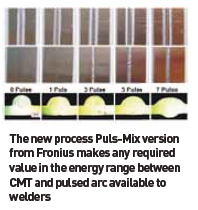 CMT (cold metal transfer) has revolutionised welding applications. Its advantages include lower heat application and less distortion, extremely stable arc control, exact dosage of droplet detachment, prevention of splatter, thinner seams - even with coated sheet metal, as well as the ability to weld metals of different types or thicknesses. Until now there was an upper limit to the power range. Combining it with pulsed arc technology removes this limitation. The new process Puls-Mix version from Fronius makes any required value in the energy range between CMT and pulsed arc available to welders. Also, there is increased process stability even with ‘pure’ pulsed arc operation thanks to the advantages of the CMT process control technology. Fronius and pilot users have placed a priority on testing the welding of critical 0.5 to 3.0 mm thick CrNi steel and aluminium alloys as preferred fields of application. Successful tests were carried out on butt, overlapped, fillet, corner and fl anged welds. In contrast to other processes, the main advantages lie in the easy control of the heat input and the very stable arc. The user can select the heat input almost continuously over the entire range of CMT and pulsed arc welding. Because of this, the zone affected by the heat for the mixing of materials, as well as the cross-section and the shape of the weld can be deliberately controlled; or the heat input can be varied with the same welding performance. This simultaneously removes the power limits of CMT while retaining its advantages. www.fronius.com
CMT (cold metal transfer) has revolutionised welding applications. Its advantages include lower heat application and less distortion, extremely stable arc control, exact dosage of droplet detachment, prevention of splatter, thinner seams - even with coated sheet metal, as well as the ability to weld metals of different types or thicknesses. Until now there was an upper limit to the power range. Combining it with pulsed arc technology removes this limitation. The new process Puls-Mix version from Fronius makes any required value in the energy range between CMT and pulsed arc available to welders. Also, there is increased process stability even with ‘pure’ pulsed arc operation thanks to the advantages of the CMT process control technology. Fronius and pilot users have placed a priority on testing the welding of critical 0.5 to 3.0 mm thick CrNi steel and aluminium alloys as preferred fields of application. Successful tests were carried out on butt, overlapped, fillet, corner and fl anged welds. In contrast to other processes, the main advantages lie in the easy control of the heat input and the very stable arc. The user can select the heat input almost continuously over the entire range of CMT and pulsed arc welding. Because of this, the zone affected by the heat for the mixing of materials, as well as the cross-section and the shape of the weld can be deliberately controlled; or the heat input can be varied with the same welding performance. This simultaneously removes the power limits of CMT while retaining its advantages. www.fronius.com
- Plant Functions
- Smart Factory
- New whitepaper: Driving carbon transparency in automotive supply chains
- Register now: Scan-First Digital Twins: A reality capture roadmap for agile, ROI-focused brownfield transformation
 Arno Guellering on harnessing shopfloor visualisation and genAI in Draexlmaier production
Arno Guellering on harnessing shopfloor visualisation and genAI in Draexlmaier production Watch now - Futureproofing factories: Agility and flexibility in production
Watch now - Futureproofing factories: Agility and flexibility in production
- Electrification
- Automation
- Sustainability
- Events
- Companies
- Materials
- Regions
- Kaizen
- Video and Audio
- Register now: Scan-First Digital Twins: A reality capture roadmap for agile, ROI-focused brownfield transformation
- Watch now: Automotive Gateway Mobilizer - Mastering Communication Challenges in Battery and EV Components End-of-Line Tests
- Watch now: Digital Transformation at Inflection Point within Automotive Manufacturing
- Magazine
- Surveys & Reports
- Newsletters
- Partner Content
- Whitepapers
- Media Pack
- Register
- Sign In




































